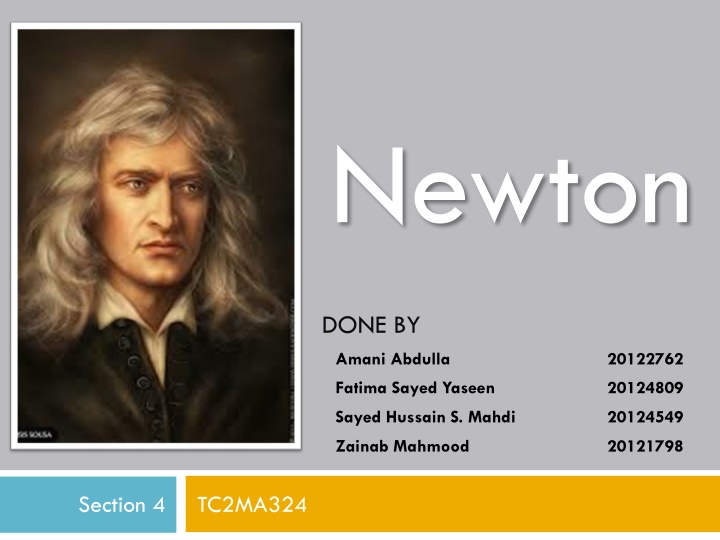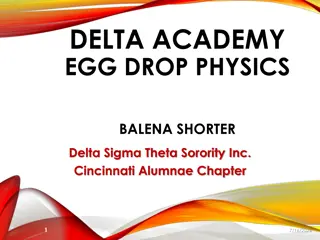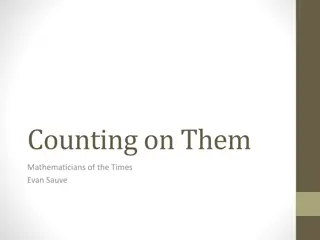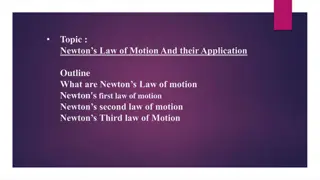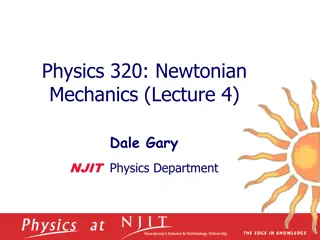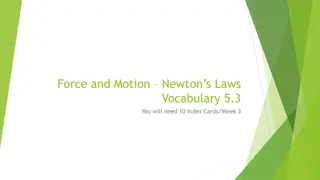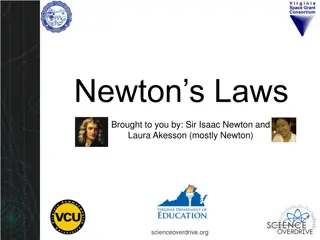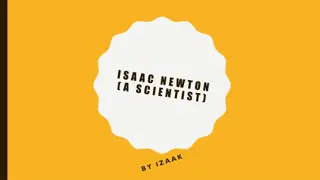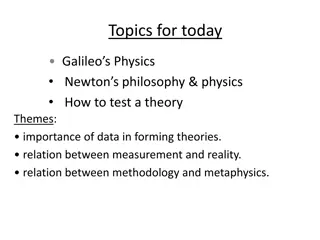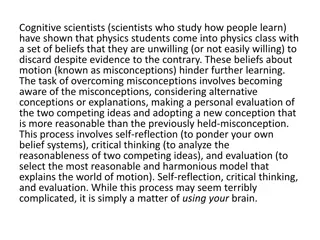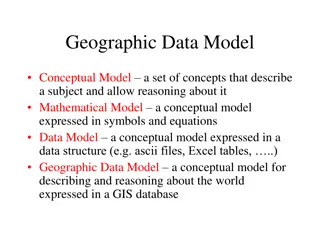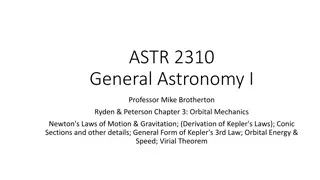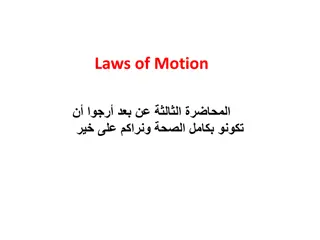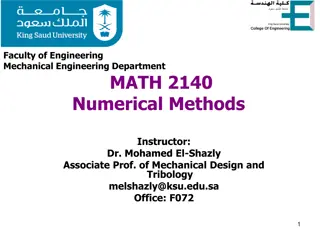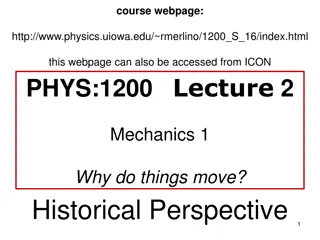Isaac Newton: Contributions to Mathematics and Physics
Isaac Newton, a renowned physicist and mathematician from England, was the greatest scientist of his era. Despite being described as 'idle' and 'inattentive' in school, he formulated the Three Laws of Motion and the law of Universal Gravitation. Newton's mathematical contributions include studying power series, developing calculus alongside Gottfried Leibniz, and generalizing the binomial theorem. His work in calculus and physics revolutionized scientific thinking and laid the foundation for modern physics and mathematics.
Download Presentation

Please find below an Image/Link to download the presentation.
The content on the website is provided AS IS for your information and personal use only. It may not be sold, licensed, or shared on other websites without obtaining consent from the author.If you encounter any issues during the download, it is possible that the publisher has removed the file from their server.
You are allowed to download the files provided on this website for personal or commercial use, subject to the condition that they are used lawfully. All files are the property of their respective owners.
The content on the website is provided AS IS for your information and personal use only. It may not be sold, licensed, or shared on other websites without obtaining consent from the author.
E N D
Presentation Transcript
https://encrypted-tbn3.gstatic.com/images?q=tbn:ANd9GcQOnniyMEnZFFMvJgK4bDOnMoNevlYhBhDFoRVdcj9iLHoq9DmtCghttps://encrypted-tbn3.gstatic.com/images?q=tbn:ANd9GcQOnniyMEnZFFMvJgK4bDOnMoNevlYhBhDFoRVdcj9iLHoq9DmtCg Newton DONE BY Amani Abdulla 20122762 Fatima Sayed Yaseen 20124809 Sayed Hussain S. Mahdi 20124549 Zainab Mahmood 20121798 Section 4 TC2MA324
Isaac Newton 1643 1727 , in England. Physicist, mathematician, and the greatest scientist of his era. His school reports described him as 'idle' and 'inattentive'. He formulated Three Laws of Motion, and the Universal Gravitation law. He contributed in optics (the refraction of light)
Contributions in Mathematics He studied the power series, generalized the binomial theorem to non-integer exponents, developed Newton s method for approximating the roots of a function shared credit with Gottfried Leibniz for the development of calculus. (Williams, M. 2014)
Derivative f(x) = c xn nn n f (x) = c x -1 q (a) = 9 a4 Example: ( )4 4 -1 q (a) = 9 a = 36 a3
Derivative f prime of x f(x) = xn f (x)= n xn-1 Example f(x) = x9 f (x) = 9x 9 1 cxn cx c x cnxn-1 c 0 1 q(a) = 9a4 j(x) = 9x = 9x1 k(x) = 9 = 9x0 g(x) = x = x1 q (a) = 9(4)a4-1 = 36 a3 j (x) = 9(1) x1-1 = 9x0 = 9 k (x) = 9(0) x0-1 = 0 g (x) = 1x1-1 = x0 = 1 156 - 149 . . 5 . . 2011 . http://obeikaneducation.com/obeikanmodules/ebooks/view_book/333/95
Derivatives of Trigonometric Functions . 32 . 6 . 2012 . . http://obeikaneducation.com/obeikanmodules/ebooks/view_book/331/95
Calculus Newton used mathematics to help him to improve his physics work Newton and Leibniz worked separately on calculus concepts Newton work through physics Leibniz work through concepts and theory Both of them said to be the inventors of calculus
Calculus - differentiation Differentiation measures the amount of change of quantity if another quantity change. for example: in every 5 seconds you pass 1 meter then , ? = 5? we will find that the first Derivative will be 5 which is speed y =5x , ? ? = 5 or 5 m/s the second Derivative will be our acceleration which is zero ? ? = 0
Newton method - proof If , then With repeating
Newton Raphson Method - Example Use Newton s method to find accurate solution for the following equation: ? ? = ?2 ? 1 for ?0= 1.5 1. ? ? = ?2 ? 1 Write the equation 2. ? ? = 2 ? 1 Write the derivative 3. ?0= 1.5 Find x0 ? ?? ? ?? 4. ??+1= ?? Write the formula ? ?0 ? ?0=1.5 (1.5)2 1.5 1 Find x1 = 1.625 5. ?1= ?0 2 1.5 1
Newton Raphson Method Contd Use Newton s method to find accurate solution for the following equation: ? ? = ?2 ? 1 for ?0= 1.5 ? ?? ? ?? 6. ??+1= ?? Write the formula Find x1 7. ?1= = 1.625 1.6252 1.625 1 2 1.625 1 Find next xn+1 8. ?2= 1.625 = 1.61805 9. ?3= 1.61803
Newton Method in Calculator ???? ??? ? ? ??? ? ?. ? ??? Use Newton s method to find accurate solution for the following equation: ? ? = ?2 ? 1 1. Write the ?0value (1.5) then press (=) , then press (AC) 2. Write the formula, but instead of (?0) press (Ans) ?? Ans Ans ?. ? 1.625 1.61805 for ?0= 1.5 ? Ans ?? ? ? ??= ?? ? ?? Ans 3. After that, press (=), then the answer: ?1= 1.625 4. Then, Only press (=) again to find next x value, so next ? ?2= 1.61805
Exercise 1. Use Newton s method to find accurate solution for the following equation: ? ? = ?3 2? + 1 for ?0= 0.6 Answer: ? = 0.4142 2. Use Newton s method to find accurate solution for the following equation: ? ? = (? 2)2 1 for ?0= 2 Answer: ??? ?????!
Exercise Contd 2. Use Newton s method to find accurate solution for the following equation: ? ? = (? 2)2 1 for ?0= 2 Solution: Error Zero
References BBC.( 2014).UK. History. Retrieved from: http://www.bbc.co.uk/history/historic_figures/newton_isaac.shtml J J O'Connor and E F Robertson. (2000). History: Sir Isaac Newton. Retrieved from: http://www-history.mcs.st-and.ac.uk/Biographies/Newton.html Williams,M.2014.Canada. What Did Isaac Newton Discover?. Retrieved on March 24th ,2015, From: http://www.universetoday.com/38643/what-did-isaac- newton-discover/ https://www.youtube.com/watch?v=cOmAk82cr9M Touger, J. (2006). Introductory physics: Building understanding. Hoboken, NJ: Wiley. Dawkins, P. (2007, August 1). Pauls Online Notes : Calculus I - Newton's Method. Retrieved March 24, 2015, from http://tutorial.math.lamar.edu/Classes/CalcI/NewtonsMethod.aspx
References No Author, (2013). Sir Isaac Newton. Info Please. Retrieved from: http://www.infoplease.com/encyclopedia/people/newton-sir-isaac.html http://ar.wikipedia.org/wiki/%D8%B7%D8%B1%D9%8A%D9%82%D8%A9_%D9%86%D9%8A% D9%88%D8%AA%D9%86_%D8%B1%D8%A7%D9%81%D8%B3%D9%88%D9%86_%D9%84%D8 %AD%D9%84_%D8%A7%D9%84%D9%85%D8%B9%D8%A7%D8%AF%D9%84%D8%A7%D8%A A_%D8%BA%D9%8A%D8%B1_%D8%A7%D9%84%D8%AE%D8%B7%D9%8A%D8%A9 http://www.youtube.com/watch?v=eNSZHWzuDvs http://www.youtube.com/watch?v=COssXEW2dw0 http://www.youtube.com/watch?v=yybxBlprzSs https://www.youtube.com/watch?v=cOmAk82cr9M Touger, J. (2006). Introductory physics: Building understanding. Hoboken, NJ: Wiley. . 149 - 156 : http://obeikaneducation.com/obeikanmodules/ebooks/view_book/333/95 . 32 http://obeikaneducation.com/obeikanmodules/ebooks/view_book/331/95 . 5 . 2011 . . . 6 . 2012 . .
